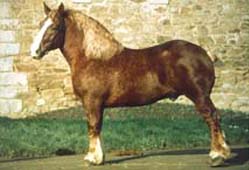Breton
N/A
Sat, 16th November, 2024 - 11:06 am GMT
Sponsor Ads:

Alternative Name
N/ABasic Info
There are three types of the Breton coming from different districts of Brittany, each bred according to the duties it must perform. These are the Heavy Draft Breton, the Postier Breton and the Corlay or Central Mountain Breton. The Corlay Breton is derived from crosses with the Arab and Thoroughbred, and stands 14.3 to 15.1 hands. The Corlay is considered the real descendant of the ancient Breton horse. It has the same general features as the draft type but is smaller with a more dished face. The Postier Breton has blood of the English Norfolk Trotter and Hackney that it acquired in the nineteenth century. It is strong has an attractive gait, and stands an average of 15.1 hands. It is bred mainly in central Brittany and makes a good coach horse and is capable of light farm work. The Heavy Draft Breton is renowned for its great strength relative to its size. It is bred in the northern coastal area of Brittany. In the nineteenth century it was made larger by crosses with Ardennes and Percheron stock. The Heavy Draft stands 15.2 to 16.2 hands and has short, muscular legs
Health
N/AHabitat
N/ABehavior
The Breton has several standard characteristics within the three breed types. Their coat color is chestnut or chestnut roan often with flaxen mane and tail, on occasion bay or bay roan will be seen. The head is square and of medium volume with a wide forehead. The nose is straight but sometimes dished, the nostrils wide, the eye lively and the ear is small. The neck is strong, slightly short but set well into the withers. The back is wide, short and muscular; the croup is wide and double; the rib cage is rounded. The shoulder is long and muscular; the limbs are very muscular and short with sound cannon bones.Origin
Bretagne (or Brittany) in the northwest of FranceHistory
The Breton originated in the province of Bretagne (or Brittany) in the northwest of France. A demanding climate and land of rather poor quality characterizes this area. Such and environment contributed to the creation of a horse possessing qualities of great strength and durability. Brittany has a history of breeding distinguished horses, which goes back to the Middle Ages. The Breton horse is the result of evolution over hundreds of years, and a long period of selection carried out by breeders from old varieties of native horses. Horses have been present in the Breton mountains from thousands of years; however, the debate over how they first arrived there still brews today. It was in the Middle Ages, around the time of the Crusades, that the Breton horse became sought after by military leaders, in part due to its comfortable gait. At that time the breed stood at about 14 hands. During the seventeenth, it was this horse that was sent to New France (Canada) by the king of France and the Canadian Hors still shows its influence. Throughout the centuries, the Breton was crossbred with various foreign and native horses including the Boulonnais, Percheron and Ardennais as the requirements for horses changed. In the nineteenth century the Breton was crossed with the Norfolk Trotter which resulted in the most distinguished type of Breton, the Postier Breton. By 1930, crossbreeding was abandoned and selection within the breed has been the basic method of improving the breed since. In recent decades, it has been a common tendency to increase the size of a draft horse to gain more power from it. The Breton, however, is an exception. The smart trot and ability to survive and work under often demanding conditions have led to the preservation of the Breton’s purity as a breed. Crossbreeding, successfully achieved with other breeds, reduced the unique qualities of the Breton. Buyers from such diverse areas as Africa and Japan converge on Brittany to buy horses for their native areas. When crossbreeding is attempted using Bretons, it is usually to improve or create another breed like the Freiberger breed of Switzerland The Breton was originally bred in the four districts of Brittany, but now has spread far beyond its birthplace. Today, Breton horses are to be found all over France, particularly in the lower mountains of the Central Mountains and Pyrenees. Due to its quality and popularity, The Breton is the most numerous of the draft horses in France and has been widely exported around the world.Common Foods
grassSponsor Ads:
Those who do not understand Unix are condemned to reinvent it, poorly. -- Henry Spencer
Breton
Coded by: BGID® | ALL RIGHTS RESERVED Copyright © 2000-2024
Disclaimer | Privacy | Report Errors / Contact | Credits








 Homosexual behavior stems from the mind or genetics?
Homosexual behavior stems from the mind or genetics?  The Best Text Adventure You Will Ever Play! The official site:
The Best Text Adventure You Will Ever Play! The official site:  Why haven't we as a collective earth met with aliens yet?
Why haven't we as a collective earth met with aliens yet?  World EcoSystem - Biodiversity Changes - Who is on board and who isn
World EcoSystem - Biodiversity Changes - Who is on board and who isn  Mouthwash - Mouthrinse - Mouth Sores - Healing Infections - Gingivitis
Mouthwash - Mouthrinse - Mouth Sores - Healing Infections - Gingivitis  Treatment for Depression
Treatment for Depression  Ultra radical and violent Islamist group that even rivals Al Qaeda
Ultra radical and violent Islamist group that even rivals Al Qaeda  An idea to have teachers who want to carry guns to school undergo some level of police training will be left up to local school districts and police departments.
An idea to have teachers who want to carry guns to school undergo some level of police training will be left up to local school districts and police departments.